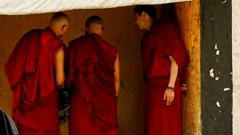Under the watchful eyes of the Chinese Communist Party, Tibet marked the Dalai Lama’s 90th birthday amid palpable fear and suppression. The Kirti monastery, located in the heart of Aba, Sichuan province, has long symbolized Tibetan resistance to Beijing's rule. As we encountered a monk shrouded in crimson robes, discreetly warning us of the complications our presence might invoke, the atmosphere felt laden with unspoken threats.
For decades, the Kirti monastery has been a hotspot for protests against the Chinese government, famous for the self-immolations of Tibetan monks resisting oppression. Inside the monastery's dense atmosphere of prayer wheels and vigilant police presence, the monk’s warning echoed painfully real: “Be careful, people are watching you.”
Functioning under the guise of development, China has built extensive infrastructure in Tibet, purportedly to enhance tourism and integration. Yet, many Tibetans claim these developments cover a harsher reality, where freedoms are steadily eroded. The Dalai Lama, viewed as a separatist by Beijing, remains a figure of reverence among many Tibetans. Yet, displaying symbols of loyalty to him can result in severe repercussions.
While protests and riots have flickered across Tibet, including the tragic events of 2008 that left numerous Tibetans dead in Aba, the last decade has seen an unyielding clampdown on dissent. Recent years have driven more than 150 self-immolations as an ultimate gesture of resistance. Current efforts by Tibetan authorities in exile continue to be monitored from afar, as the control over Tungjin—environment and expression—tightens further.
On the eve of the Dalai Lama’s birthday, we returned to the monastery for morning prayers under the soft glow of dawn. Monks crowded the hall, gathering in their yellow hats to chant quietly, reflecting the lingering hope despite draconian measures imposed by the Chinese government. “The Chinese government has poisoned the air in Tibet,” one monk lamented. He went on to express profound disappointment over the systemic oppression that stifles their rights and beliefs.
News of the Dalai Lama's succession plan, made public, reverberated with mixed emotions among the Tibetan diaspora but remained largely unreported in Tibet itself—a testament to the tight grasp of censorship. Beijing’s declarations promise supervision over the next Dalai Lama's selection process, asserting it must align with state requirements, thereby threatening the authenticity of such a spiritual transition.
Half a century of Chinese rule has entrenched a wedge between Tibetans and their identity, with new regulations mandating the erasure of their language and culture from educational systems. Elder monks expressed sorrow for the destruction of once-thriving institutions for Tibetan learning, exacerbating fears that future generations might lose touch with their rich heritage.
Beijing’s ambitions manifest in a contrasting reality where thriving tourism initiatives cater to the interests of Chinese visitors while marginalizing local voices. Amid the burgeoning development, surveillance and restrictions grow in synchronicity, leaving the Tibetan people grappled in a web of cultural erosion.
As discussions around the Dalai Lama's future unfold, the stakes have never been higher for Tibetans. Tensions between what China desires and the spiritual aspirations of Tibetans loom large. Will Tibetan culture endure against the tide of oppression, or will it find itself diminished to a mere relic of historical significance? The trajectory of Tibet underlines a persistent struggle—an ongoing resistance nurtured by resilient hearts against a backdrop of silence.


















